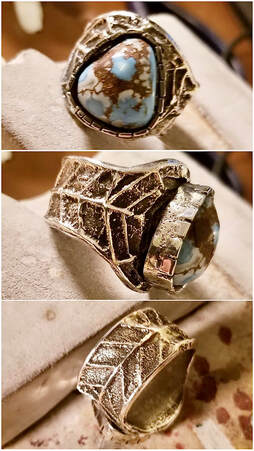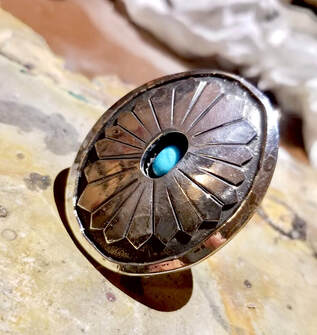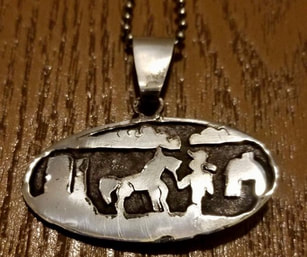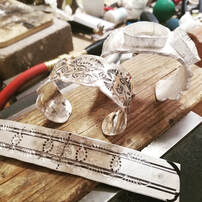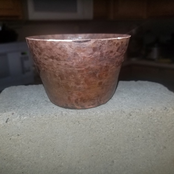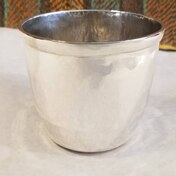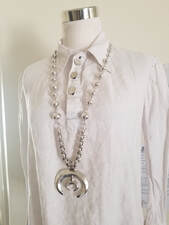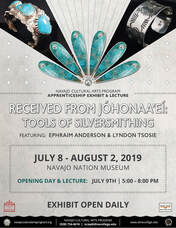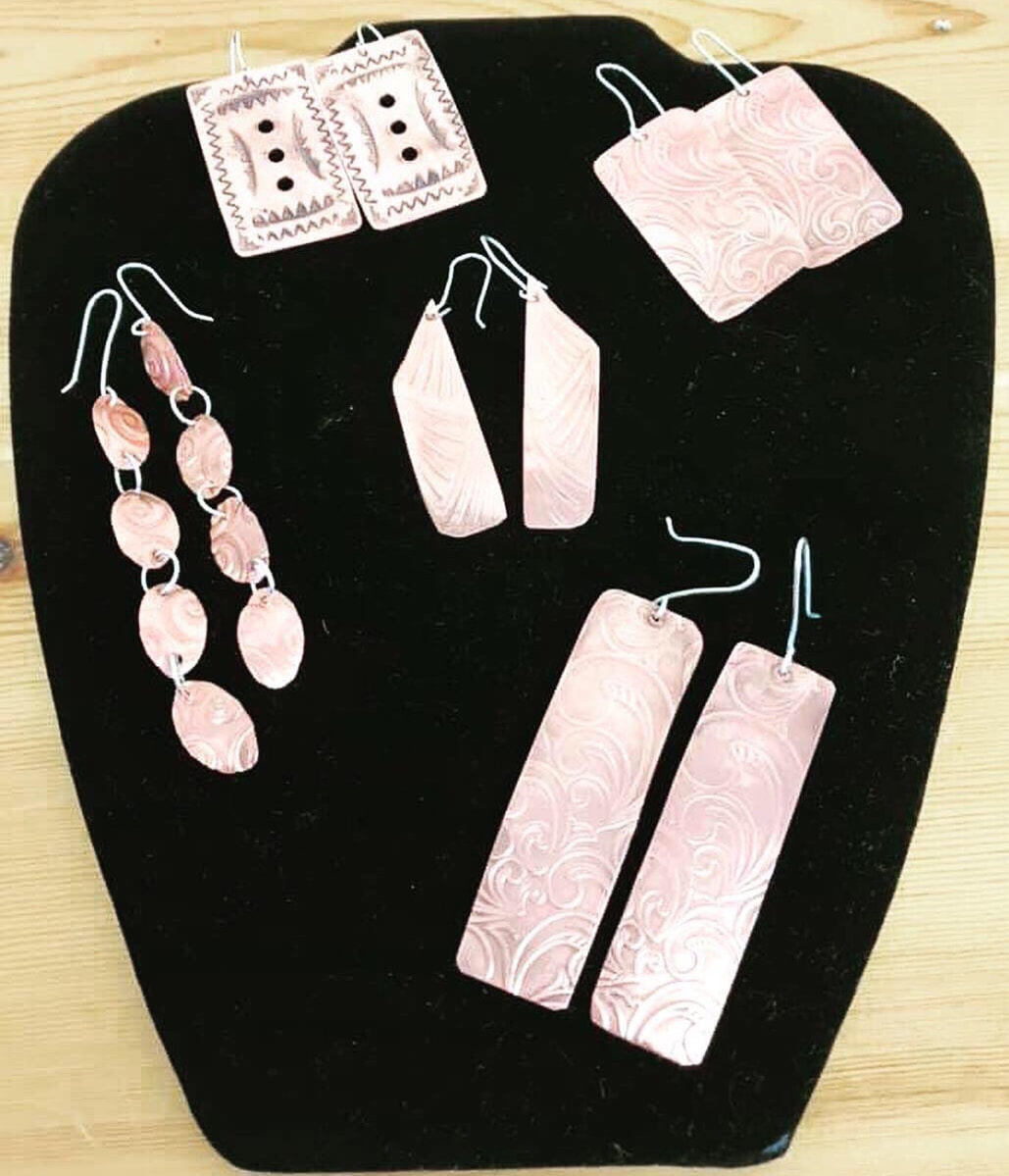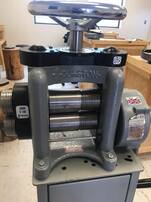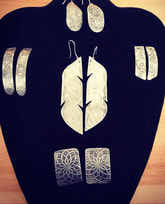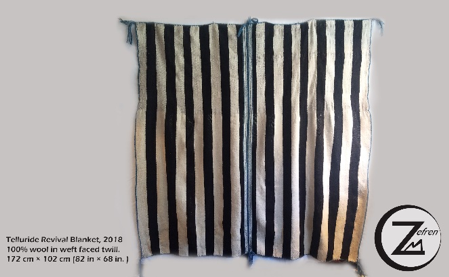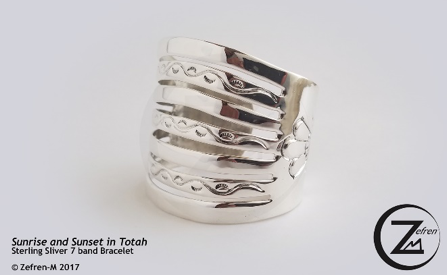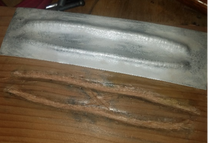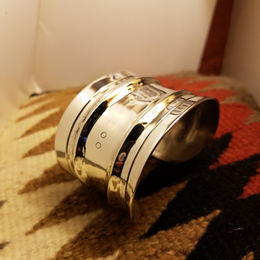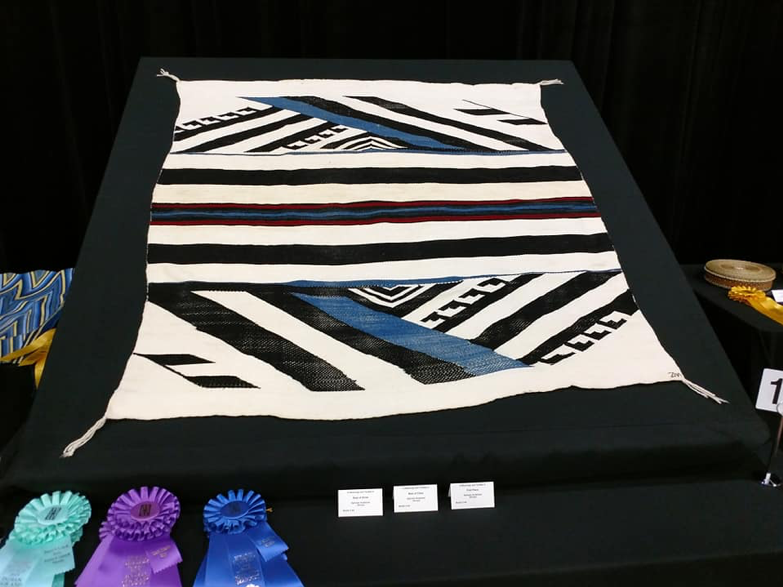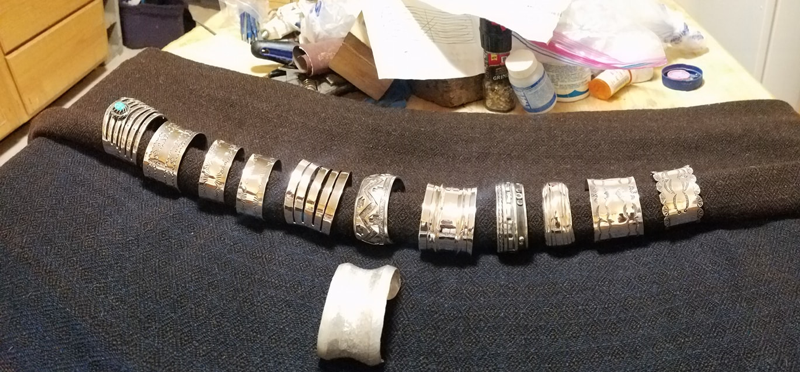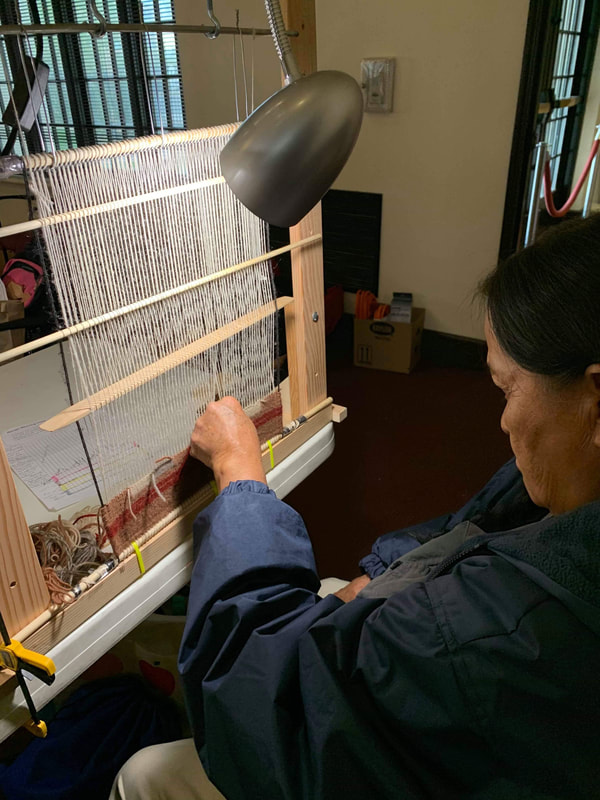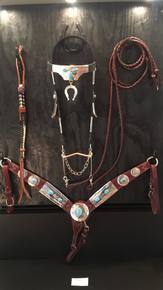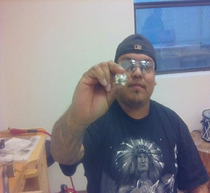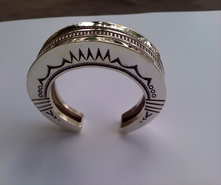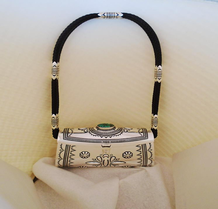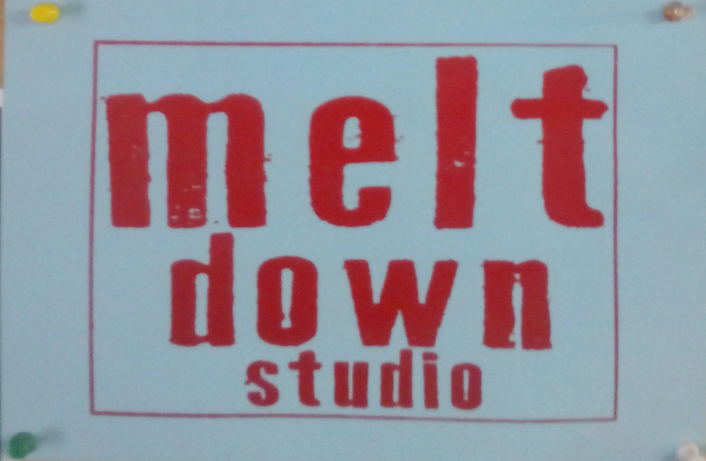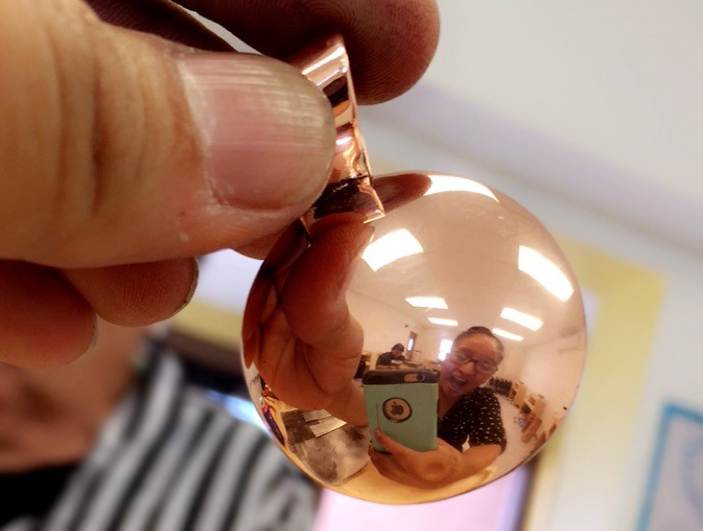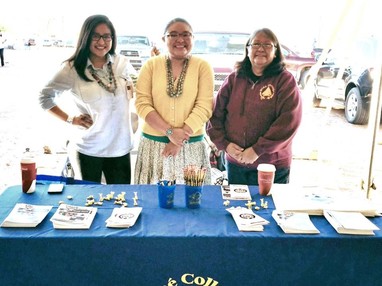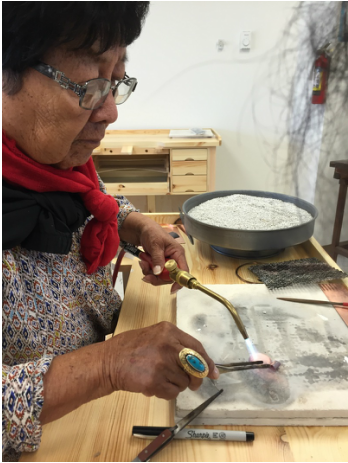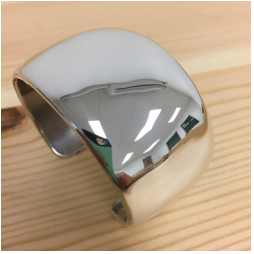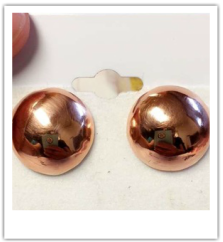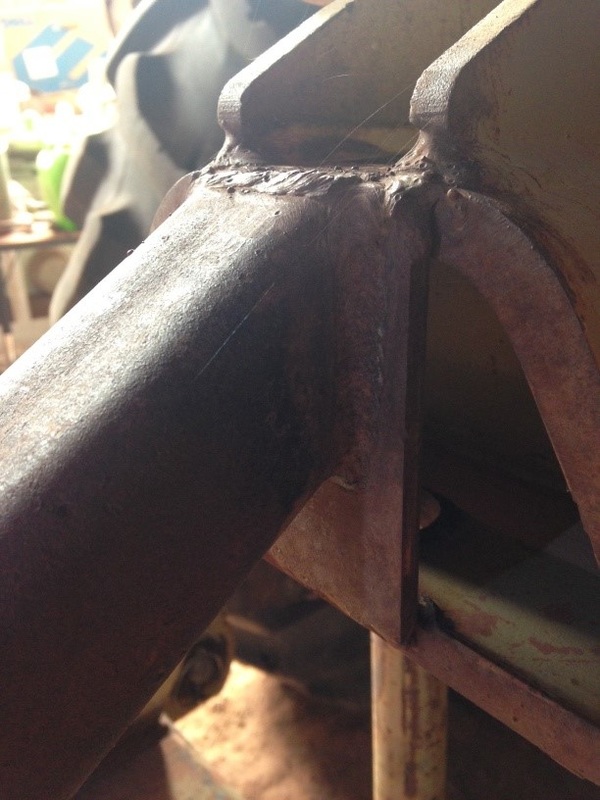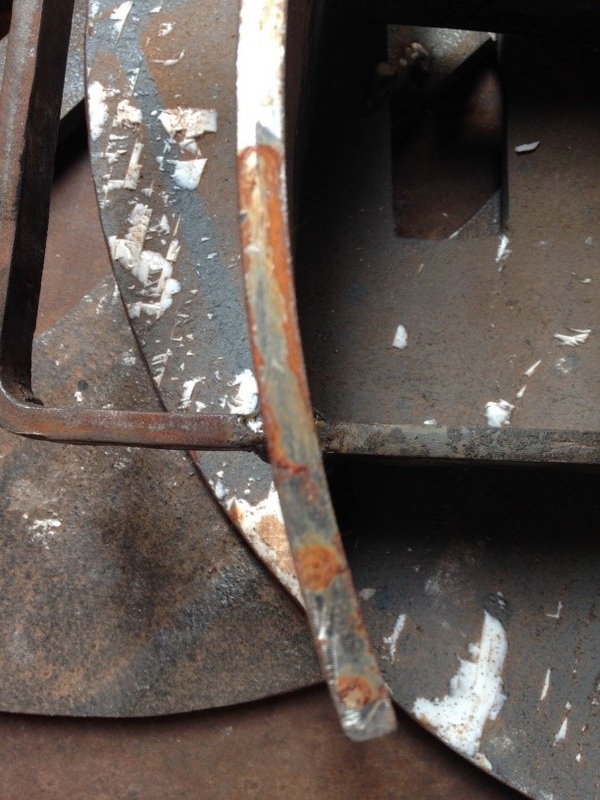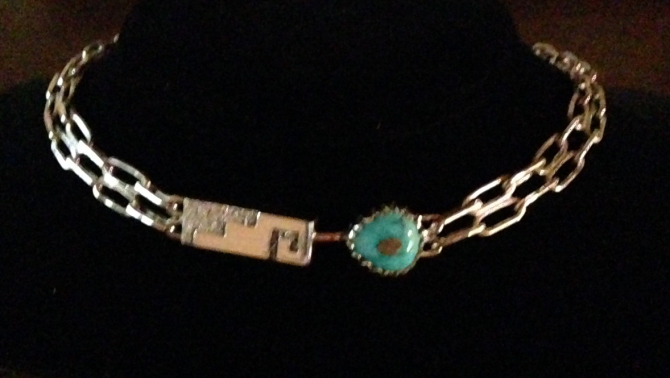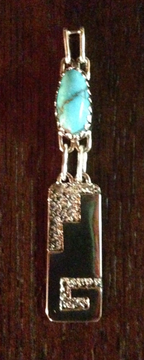Tavian NutlouisNavajo Cultural Arts Certificate, Dual Credit Student, Silversmith My name is Tavian and I am a student at Navajo Pine High School. I am also a silversmithing student at Diné College as part of the Dual Credit Program. That means that I take college credit courses while completing my high school degree. This is my 4th silversmithing class here at the Diné College and my 3rd class with my instructor, Teddy Draper, Jr. This semester was very challenging, informative, and fun! I learned so much and am excited for this coming summer because I’m thinking of all the projects I’ll make. But enough of my general thoughts - let's take a look at my CA408: Intermediate Silversmithing projects - all done online - all done while I was trying to stay a top of my high school work - all done during a pandemic :)
The fourth project I had issues - actually major issues - it was a tufa cast project. After heating up the silver, pouring it continuously. The silver would either fill up and overflow or it would pour but still not fill the design to the bottom. After carving the design again, creating more vents - the tufa cracked. I researched and reached out to Teddy, we figured it out, so I carved the design again. But I guess this project was just not meant to be for now....I accidentally bumped it off the table and it broke in half. This was so infuriating; I couldn’t finish the project as the situation worsened. Like I said before - sometimes the silver makes the final decisions and sometimes, you don't like silver's decisions. But silver not pouring the way I wanted was not a waste- it was pouring the way I needed. I needed to self reflect. Being a high school student and a college student is exciting but it is a challenge and you have to be willing to put in the extra work. Typically, I’m really good at managing my responsibilities: sports (football, basketball, and baseball), high school assignments, and silversmithing. But this semester was particularly rough and I started falling behind what when I lost three relatives in one week - it was almost impossible for me to forget that we were in a pandemic, even sitting behind my silversmithing desk. I decided to make my family a priority. I knew I was going to fall behind but family comes first. I am not the type of person to make excuses, I like to be held accountable, and I held myself accountable for my late work. The NCAP team did hold me accountable - but in a family way. They found me! They pulled me back into activities like the Spring Navajo Cultural Arts Virtual Exhibit hosted by the Native American Arts Magazine Online. Can you believe it? My work featured online! They pushed me to get back into contact with my instructor and they got me to catch up the best I could. I remember when I first started silversmithing, Teddy told me, “Move at your own pace, put in a lot of effort, and don’t be LAME. Make something nice you’ll be proud of”. I’ve always kept that in mind and did my best this semester to not be lame and to be proud of myself. I’m glad I participated in silversmithing classes, it helped me in many ways. I appreciate the art and can’t wait for summer to make more awesome jewelry!
1 Comment
Zefren AndersonNCAC Apprentice 2018/19 (Silversmith)
I didn't have to imagine. This was my reality this Spring 2019. My Choice? I wanted to take my silversmithing skills to another level, work with heavy gauges of silver, and sell my work alongside my weavings. Who was there to help me? Lyndon Tsosie and the NCAP Apprenticeship Program. At Lyndon’s shop, I became comfortable working on basic chains. And as time passed and with Lyndon's help, I learned how to make heavier jewelry as well as jewelry that was lighter for everyday wearing. I also focused a lot on my design. Lyndon’s tips and knowledge on raising metal allowed me to reach a new level of skill and aesthetic. So here is what I learned...
The attentive master jeweler, Lyndon, would wait until I asked a hard question or expressed frustration at what I was doing. Those lessons received and tips became part of my tools. Lyndon taught me that he was a tool as well. He would say: “I’m a tool here and that is how you are going to learn more than I can teach in my entire lifetime because everything around you can teach you and can be tools. So respect them and keep learning.” Working with thick gauges of 10 or lower, learning how to manage the heat properly, and selecting the correct tools were great take aways from my time as an apprentices. As my supply list grew prepared myself to raise silver into a vessel perhaps a cup or tumbler. A bigger torch, heavier hammers, anvils and several copper plates contributed to my practice sessions. While the NCAP provided funds for this journey, I had to learn how to budget so I only had enough left to purchase one silver 6x6 18 gauge piece for the final piece. After four weeks of visiting Lyndon and finding some weaving time in between visits, I completed the final assembly of my necklace and I did my final buff on the bracelets. Then the challenge began - I started raising the sliver. Every day, for 5 days, I was working at least 6 hours on the hammer work of the cup, slowly coaxing the sliver from flat sheets to organic vessel. Every course needed annealing and every morning my hands and arms would ache and cramp but I pushed through finally knowing that it takes all your tools, used properly and with respect to shape art. The cup was simple but I became more than just a cup with every hammer blow and cramp. Then... it was all over. The pieces were done. But before I turned the pieces in for my mini exhibit, it was time for critique of their style and wear. Positive reviews all around with remarks that the pieces that are heavy are rightfully so and that pieces that look heavy were surprising lighter than expected, which attest to their value as a everyday wearer jewelry. The biggest critics were from the NCAP grant manager, Christine Ami and my mentor Lyndon Tsosie who both ran a list down of the stages where I could have done better but complimented on the execution for a new silversmith. Their last words were of encouragement and of how being pushed will tighten the bar between novice and master craftsperson. They reminded me that I should reward all the hours, pain, perseverance, devotion to design and crafting with a good life. Just like the first lesson, the first tool I was given the principal of Sa'ah Naagháí Bik'eh Hozhóón from Wilson Aronlith. So I look forward to more as I continue to work with Diné College and The Navajo Cultural Arts Program. Thank You! AND... Stop by to check out the creations I made during my apprenticeship at the Navajo Nation Museum from July 8 - August 2, 2019. Opening Night will be July 9th from 5-8pm. The title of my exhibit will be "Received from Jóhonaa’éí: Tools of Silversmithing." I hope to see you all there !
Irvina CheeNCAC Emerging Artisan 2018/19 (Silversmith)
I could become familiar with the tools, materials, and time that it would take to make these earrings.While that was a pretty cool learning experience - it was the workshop itself that took place on April 17th that truly made this experience worthwhile.
We had a tremendous amount of fun getting to know each other. After introductions were given and the “Ayes” were had, the safety gear went on. With their natural talent for designing, we got to do some stamp work and rolling plate designs on 24 gauge brass and 20 gauge silver. The end results were spectacular pairs of earrings they got to take home with them! They were both very inspiring to get to know and demonstrated that the student can sure teach the teacher. They revealed to me that everything an artist touches is art even if the materials are different. Although I am sure it was a transition for them - working with the rough destruction process of metal work instead of with gentle spinning of wool - swapping metal tools for their cedar tools they were used to. It took a little bit of elbow grease and teamwork to complete the rolled earring. Very much well worth the sweat though. We had a lot of laughs and fun with the rolling plates. The biggest challenge we found was getting the perfect amount of pressure for the end result we wanted. My goal was to convey to the participants that the first thing silversmithing asks of you is the ability to channel your passion for creation. I hope that message came through!
I had a ton of fun connecting and encouraging! I hope to visit this mother and daughter duo in from Spider Rock sometime this summer. Ahe’hee for this experience! Zefren AndersonNCAP Apprentice 2018/19 (Silversmith) I was only seeking cultural knowledge to back my weaving when I first joined the Navajo Cultural Arts Certificate Program in 2017. The program required that I select an emphasis area and at the time I wasn’t looking to expand my artistic ability past weaving. But I also recognized that silversmithing was an option in the program. A small moment of self-doubt, much like when I first filled out the application for NCAP went through my mind. As I contemplated adding silversmithing as an emphasis area, I asked myself, “was this going to worth my time away from my loom, friends and family?” The possibilities of “what if?” were at first negative - "what if it takes away from my weaving? what if I am not good enough?" I signed up anyway for my silversmithing classes with Wilson Aronilth and looking back on that decision...my :what ifs" have become “what if I had not?” Every class, mentor and event that NCAP included only strengthened my understanding of K'é, which is both a Navajo philosophy and Navajo skill. Those moments of self-doubt are no longer signs of weakness but great turning points where life changing decisions are made. By the end of the program, my weaving did not suffer - I received the Legacy of a Master Weaver award for my stripped blanket at the 2018 NCAP Exhibit. I took a gambled with that rug - another area of self doubt - my decision of reviving older styles of weaving. And guess what....my gamble selecting a second emphasis area paid off. Starting with sheet of 3x6" sterling silver plate during the cohort I received a ribbon for a simple split shank bracelet. They were recognized by established silversmiths and weavers as great examples of Navajo Art even though I didn’t feel like they were. To me, they were just small aberrations in the cosmos that is Human existence. Fast forward to 2019 and I’m now an expert at trudging past the small pauses of why? NCAP did that. The Program gave me the ability to plan and work independently while developing relationships that strengthen Navajo culture. I find myself doing activities outside my comfort zone with a Certificate of Navajo Cultural Arts in hand. I’m doing this while also continuing to weave full time for Native American art Shows and being a caregiving to my father. Life didn't stop me from applying and receiving a NCAP Paid Apprenticeship. Through that gamble I was given the opportunity to learn from Lyndon Tsosie, a world renowned Navajo Silversmith and owner of the House of Stamps in Gallup. Little did I know at the time that his advice would have life altering affirmations of the path NCAP put me on. “You have to earn your chops” and “believe in your work as you design it, not as the experts defines it” Those are the central lessons I learned from Lyndon as we both concentrated on the 61stHeard Museum Guild Indian market and Art show. During my time with Lyndon, I asked about older techniques and styles of Navajo Jewelry and Lyndon responded with a trove of knowledge and experiences that I have yet to utilize personally. But I have learned that with the simplest tools, great art can be created, nurtured and shown to hold its beauty among others styles. Another moment of self-doubt - Submission time to the Heard. I was fully prepared to defend my work. I had three weaving pieces to submit with one sliver bracelet- A total of 4 pieces but the limit was 3. For a split second, I wanted to switch out my weakest weaving for my bracelet as the other two weavings were made for the expected standards of Navajo textiles. My weakest piece was an experiment and broke almost every rule of the standard of Navajo weavings. A split second later, I walked out with my bracelet and I left my atypical, experimental weaving to be juried. What if I had NOT! That experiment - that piece that I thought had the weakest possibility of placing - Won best of Show at the 61st Heard Museum Guild Indian market and Art show. I brought home ribbons and an empty bracelet case. Even a half done bracelet that wasn’t buffed sold! I urged the client to wait until I had polished the edges with a rock making a comfortable hand formed bracelet for them. Now I understand having integrity in one’s art even if it’s different because if you work at making it the best it can be it will support you and someone will find it beautiful. I’m am excited to see what happens next because... what if I had NOT?! Irvina CheeNCAC Emerging Artisan 2018/19 (Silversmith) Ya’ateeh, My name is Irvina Chee. Women Empowerment nishli’, Passion Ba’ shischiin, Resilient Dashicheii’, Empathy dashinali’. Shi Ne’hema dee’naasha’. Those are my “clans” that helped me identify my brand for a Workshop we did with Mr. VanDeever as a part of the Navajo Cultural Arts Program (NCAP). My emphasis in the NCAP program is Silversmithing.
One semester down in the program and I have learned so much more that just how to silversmith. The program is one of the most unique experiences I have ever had in a college setting. Unique and special in all its teachings not just in the emphasis you choose. Day one in the NCAP program started out with a butchering demonstration that all of our bellies appreciated! It was not only a great way to get to know my fellow cohort members, but it also showed us how the NCAP staff works together, how they collaborate with other organizations, and how the cultural arts doesn't just start in the classroom in this program. Within the silversmith cohort, I have met some very special people! Within the silversmith cohort, I have found a tool to further beautify my heart, mind and surroundings. And within the cohort, I learned what peace of mind can produce. In your hands, solid and ready to adorn. Our first semester, our instructor Anthony Goldtooth had us perfecting our stamp work and finding our own individual styles. He shared stories of his own path to becoming an artisan himself and how he is following in his father’s footsteps, Tony Goldtooth, whom is a Master Silversmith. Those were by far, my favorite stories. Every class was a different teaching on technique and metal manipulation. Personally, I find the art very therapeutic and adaptive to me and a hammer. The beauty left behind, after some buffing and polishing of course, is holisticly satisfying. I absolutely fell in love with it. I look forward to next semester and to learning new techniques on how to work with metals and stones. I am very excited to soak up everything that the program has to offer in the near future, as some artisans have decided to do all the programs (which you can do too!). I hear there is a Shoe Game we will be attending to learn how Navajo business systems starts with this game. There is also mentioning of field trips to Trading Posts, Museums, and Galleries too. I find it so amazing that no place else on Ni’himá can you get these teachings than at Diné College. I also must say It also does not hurt to have Tsaile provide the appropriate backdrop for such an experience. The campus and the land are beautiful year round. Thank you very much for the knowledge and opportunity to live my dream. Again my name is Irvina Chee, I am from Marble Canyon Az. Ta”neeszahnii nishli’, Kinlichii’nii’ bashishchiin, Kinyaa’aanii dashicheii, Ashiihi dashnali’. Ahe’hee! Mazie WillieNCAC Emerging Artisan 2018/19 (Weaver)
I am a weaver in this year Navajo Cultural Arts Certificate Program. My cohort member is Tamerra Martin and our instructor is Ilene Naegle. We weave together at the Window Rock Diné College Branch on Wednesday afternoons. It has been great working with these ladies - but through the NCAP, I was able to learn a little more about the cultural arts - specifically silversmithing. Therefore, I would say that my favorite NCAP activity during the Fall 2018 semester (besides going to weave at the Heard Museum) was working with silver and natural stones in our NIS129 Materials and Resource Class. Most of the people that I know who do silverwork, work in their homes whenever they can. Their homes usually have electricity where the buffering is done with electricity. At one time every thing was done by manual labor. Up to now, it seemed like silversmithing was a costly hobby with a costly initial investment. It takes time, money, and labor to produce quality art pieces. That's why I was excited when one of our workshops was on silver bead making. In the workshop, Dr. Christine Ami presented on types of metal (copper, brass, silver, gold), different gauges, and variations of the natural stones. She even mentioned how coins were originally used by Navajos for silversmithing. Dr. Ami had some high quality handmade- jewelry pieces that her husband had made. She gave us tips about buying materials and selling the art pieces. I don't think such advice is clearly given to new artists so freely. At the end of the Dr. Ami's presentation, the former 2017/2018 Miss Navajo, Crystal Littleben did a hands on workshop. Miss Littleben was very helpful and attentive. She worked with us on cutting, stamping, soldering, and buffing of the silver beads. We started with copper and then moved into silver once we got an understanding of the process. I know everyone had a memorable day at this workshop because it was fun and interacting. At the end of the day, we produced an art piece. Thank you both, Dr. Ami and Miss Littleben, for your time, skill, knowledge, patience and everything else too 😄. Now, these two ladies not only know the art work but both are very smart, supportive when working with people.
Johnnie Bia, Jr. Diné College Psychology BA Intern, Office of Miss Navajo Nation
As I look into the Diné holistic components of Navajo silversmithing, I reached out to Master Silversmith, Leonard Gene and Emerging Silversmith, Waycee Harvey for some guidance. Leonard is Tó'aheedli'inii, born for Bit’ahnii, his maternal grandfathers are Ashii'hi, and his paternal grandfathers are Hashk'a'a i Hadzohí. He is originally from Rock Point, AZ. Waycee is Tachinii, born for Kinyaa'áanii, his maternal grandfathers are Todichinii, and paternal grandfathers are Tlaashchii. He is originally from Many Farms, AZ. He is apart of the 2017-2018 NCAP cohort and learning silversmithing from Don Denetdeal and Wilson Aronilth, Jr. I also took advantage of revisiting previous blogs written by former NCAPers, Delia Wauneka and Carlon Ami, to understand how the process of silversmithing makes us holistically unique.
frame, scribe, saw blades, files, acetylene tank, pliers, and creativity. This was the shopping list that was given to Waycee when he first started learning how to silversmith. From that basic tool kit, a silversmith can build up their supplies depending on the specialization they select (or I could also say the specialization that selects them). Specializations can include everything from stamping, overlay, in-lay, lapidary work, sand casting, tufa casting, and so forth.
feeling to the silversmith too - particularly when you finish a project to your liking. Delia also explored this elation in her blog "Wauneka's Meldown." On a NCAP trip to Meltdown Studios, Delia challenged herself to learn different techniques like chemical and electric etching. She also desperately wanted to learn how to make her own beads. It was somewhat of an emotional roller coaster: "I watched as Lauren did her demonstration, yet I struggled with this project and I decided to put it aside. Later on the day, I confronted my own self-doubts and challenged myself to finish one bead. You know what… I did it! I am so proud that now I can say, 'I made my own bead'". Delia explained that her self doubts were over come by her persistence. This is what Leonard must have meant when he reminded me that when you complete a project, it uplifts your spirit and makes you respect yourself for what you have done.
toughness you have to have. Carlon also wrote of this toughness in his blog "Just Take It Apart and Put It Back Together": "Don't let convention limit you. If you can reasonably imagine it, you might be able to build it. If it doesn't work out, you can always melt it down later for casting material." At the end of the process, there is a sense of satisfaction for completing the puzzle and having your ideas all come together. But the mental challenges don't stop there. When your done buffing and publishing, Leonard explained, there is a motivation released that inspires you to make improvements on the next project.
gives you another level of respect about what our culture means. With this understanding, you can have prayers done every now and then to help your work along and to keep you strong so you can continue your work with positive motivations. You can also sing songs while you’re working. It helps to stay connected with our traditional culture and values. After speaking with Leonard and Waycee, reconnecting with Carlon and Delia's blogs, and sitting in on some of the NCAP silversmithing classes, I can begin to understand how silver work helps an individual’s holistic well-being. There are physical demands when working with silver, sacred stones and minerals but you get energy, stamina, and motivation from them as well. Silversmithing is an emotional journey, bringing joy to you and others when your work is completed, even amidst the self-doubt and frustration during the process. This cultural art helps your mind to focus on the positive, which in turn, helps maintain creativity within your work. Ultimately, silversmithing as a Diné individual evokes a spiritual feeling through the stories and history of how Navajo people have always had silver and the sacred stones. Silversmithing has many benefits for a person who wants to learn. It will give you as much as you want to give to it.
And with that said...
Jerome Nez Emerging Artisan, Silversmith, NCAC 16/17 Hello! My name is Jerome Nez and I am a student at Diné College in Tsaile, Arizona. My clans are Salt Water (Todik’ozhi), born for the Salt People clan (Ashiihnli). My maternal Grandfather is of the Red Running into the Water clan (Tachiinii clan), and My Nalii are of the Honey Combed Rock (Tse’njikini clan). I am a community member of Whippoorwill, Arizona (Navajo Nation). These are my roots and who I am. Although I am carpenter by trade, I decided to add to my bag of tricks through my enrollment with the Navajo Cultural Arts Certificate Program. I am part of the 2016/17 Silversmithing Cohort, preparing for graduation this May! Thus far it has been a great experience and rewarding to be part of NCAP.
Along the way we have made some stops. One place we visited was the Gallup Trading Company. Not only does it have a lot of neat things to buy that are completely old school but also, the building structure of the shop is old-styled and pretty cool in itself. In addition to the jewelry, Gallup Trading Company sells stones. The quantity and quality of turquoise were impressive and the friendly people working there made for a nice, calm stop. We purchase a few stones and then continued our trip but not before our delicious stopover at Diné Grill to get our Mutton and Taco fix.
The next day we started our two day workshop time at Meltdown Studio! We learned, created, laughed, and met some wonderful people. Those couple of days of jewelry making has tied us all together, helping us to form bonds of respect and admiration. While at the studio, Lauren showed us techniques in stamping, hammering, bead making, bezel forming, wire bending, torch usage and overall tips that we could apply to our daily silversmithing practices. We had almost unlimited access to everything in the studio and we could make as much jewelry as we wanted with what was provided - If we only had more time! At Meltdown
What a huge honor it is to be part of NCAP and the teachings that I have learned and experience have helped me to grow. I have noticed that many techniques in Silversmithing seem too advanced and impossible to do at first. But with examination, study and practive, I know it can be done and it is possible. The first step you need is a positive attitude. That positivity will brush off on everything, although a lot of practice is still required. Places like NCAP and Meltdown Studio are excellent starting points.
One piece of advice from me: If you want to add a little bling to your life, you can first practice making jewelry with inexpensive pieces, so that you can get the hang of it. This way you don’t end up ruining your precious stones and metals. That is what I did – and now I am moving on from copper and brass to silvers and stones. You can stop by the 2017 Navajo Cultural Arts Museum Exhibit from April 17-21 to see some of my silverwork! And don't forget to vote on your favorite piece for the community choice award ;) A posting by Crystal Littleben, NCAP Project Coordinator You are probably wondering, what is this Littleben you speak of? Well, my name is Crystal Littleben and I am the Project Coordinator for the amazing Navajo Cultural Arts Program (NCAP). While I call two places home, Round Rock and Tuba City, Arizona, I am quickly starting to feel at home with NCAP here in Tsaile as well. I am of the Red House (Kin Łichíi’nii) clan, born for the Coyote Pass (Ma’ii Deeshgiizhnii) clan. My maternal grandfather’s clan is the Bitter Water (Bįįh Bitoo’nii). My paternal grandfather’s clan is the Under His Cover (Bit’ahnii).
It is mindboggling (in a good way!) to reflect on the little time I have been with NCAP and the amount of growth I gained both professionally and personally! Growing up, I have always been naturally drawn to my Navajo language, culture, and arts. I am and will always be a lifelong learning of our Navajo language and culture… so, being offered the job as the Project Coordinator for NCAP was a great way to continue my journey of Sa’ah Naagáí Bik’éh Hózhóón.
Amongst the responsibilities of a Project Coordinator, I had the opportunity to be a part of a Weekend Silversmith Workshop led by Mrs. Martha Jackson. I had only been on the job for two weeks but I was ready for some hands on experience. I have never tried my hand at any sort of silversmithing work. So, when Mrs. Jackson invited me to participate with the workshop, I was completely caught off guard. I had no idea what I was doing, didn’t know the “silversmith” language, and definitely, didn’t know how to use the tools. But if you know me, inexperience won’t stop me!
I have tons of NCAP stories to share with you and I hope you all continue to read our blog. So stay tuned! Follow us on our Website, Facebook, Twitter, and Instagram.
A posting by Carlon Ami, NCAP Intern I'm not sure anyone believes me when I tell them that I learned to drive a tractor before learning to drive a vehicle. Either way, this is fact. Also important to this fact is that I learned very early in my tractor use that things break. Now that equipment is not cheap, and you have to learn how to either hide what you break (like my uncles do) or get it fixed. Thankfully, my older brother is a pretty awesome welder. I don't say this just because he's my brother or because he has saved my butt more times than I can remember but because he taught me a critical lesson once. I was stressed because I somehow bent the support beam of the blade that keeps it perpendicular to the surface of the ground. There was no way that thing could be fixed, I almost just bought a new one. He had me bring it to him, he checked it out, then got to work. Over the course of a couple hours we laughed, sweated, cursed, and learned. His advice: "Just take it apart and put it back together." Since welding is very closely related to soldering I apply that same concept to jewelry fabrication. How do I make this fit? Is this going to be strong enough? Can I do this? The answer: of course you can. Don't let convention limit you. If you can reasonably imagine it, you might be able to build it. If it doesn't work out, you can always melt it down later for casting material.
|
Categories
All
Archives
October 2021
|
SocialsALL PHOTOS IMAGES ARE COPYRIGHT PROTECTED. PHOTO IMAGES USE IS SUBJECT TO PERMISSION BY THE NAVAJO CULTURAL ARTS PROGRAM. NO FORM OF REPRODUCTION IS PERMITTED WITHOUT WRITTEN PERMISSION FROM THE NAVAJO CULTURAL ARTS PROGRAM. |
Featured Pages |

